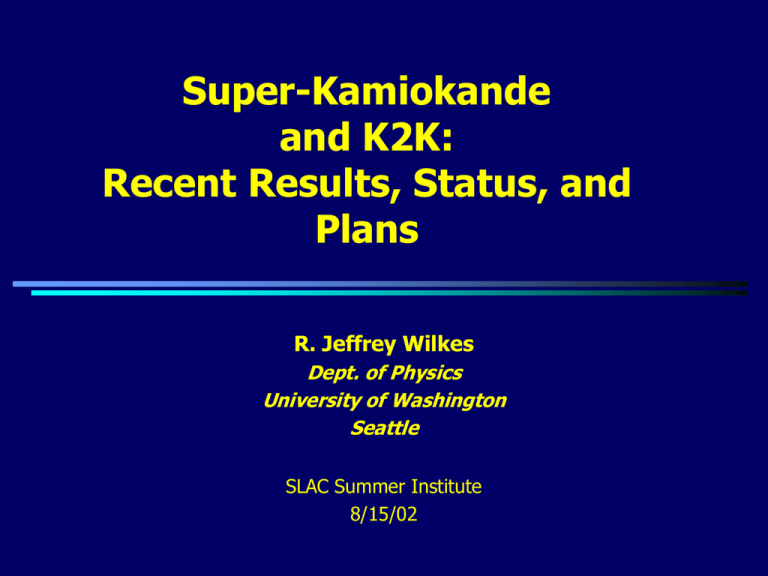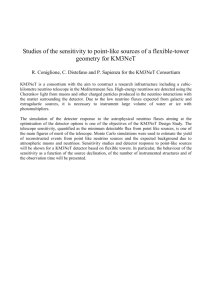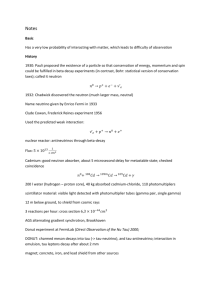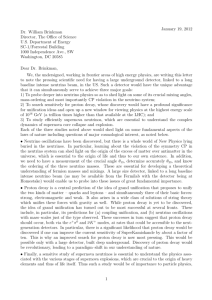Super-Kamiokande: Neutrino Oscillations Analysis
advertisement

Super-Kamiokande
and K2K:
Recent Results, Status, and
Plans
R. Jeffrey Wilkes
Dept. of Physics
University of Washington
Seattle
SLAC Summer Institute
8/15/02
Super-Kamiokande and K2K
Toyama
SK
KEK
Super-Kamiokande Neutrino Observatory
•
•
In Mozumi mine of Kamioka Mining Co, near Toyama City
Detects both natural (atmospheric,solar) and artificial (K2K) neutrinos
K2K (KEK to Kamiokande) long baseline experiment
•
•
Neutrino beam is generated and sampled at KEK (national particle
physics lab, near Tokyo)
Beam goes through the earth to Super-K, 250 km away
The Super-Kamiokande Collaboration
Japan
ICRR, University of Tokyo
High Energy Accelerator
Research Organization(KEK)
Gifu University
Kobe University
Kyoto University
Niigata University
Osaka University
Tohoku University
Tokai University
Tokyo Institute for Technology
Tokyo University of Science
Korea
Seoul National University
Poland
Warsaw University
USA
Boston University
Brookhaven National Laboratory
University of California, Irvine
California St. Univ, Dominguez Hills
George Mason University
University of Hawaii, Manoa
Los Alamos National Laboratory
Louisiana State University
MIT
University of Maryland
SUNY / Stony Brook
University of Washington, Seattle
Super-Kamiokande
Electronics
Huts
Linac
cave
Entrance
2 km
Control
Room
Tank
Outer
Detector
•
•
•
•
Inner
Detector
Water
System
Mt. Ikeno
•
•
•
•
•
US-Japan collaboration
(~100 physicists)
50,000 ton ring-imaging
water Cherenkov detector
Inner Detector: 11,146
phototubes, 20” diameter
Outer Detector: 1,885
phototubes, 8” diameter
Began operation in April, 1996
Published first evidence for neutrino mass in June, 1998
Typically measures neutrino interaction location to within
25 cm, arrival direction to within few degrees
Typically records about 15 neutrino events per second
See website for more info: http://www.phys.washington.edu/~superk/
The problem in a nutshell…
•
Roz Chast, Scientific American, 5/02
Checking tubes by boat as the tank fills (1996)
• Each photomultiplier tube is 20 inches in diameter!
Neutrino event displays: ne and nm
Electrons scatter in water and produce fuzzy Cherenkov rings;
Muons travel in straight lines and produce sharper rings
Outer Detector
Inner Detector
Electron
Neutrino
Event
MUON
Neutrino
Event
Super-K Detector Geometry and Event Types
Rock
Stainless
steel tank
PARTIALLY
CONTAINED
NEUTRINO
FULLY
CONTAINED
NEUTRINO
2.5m
Inner Detector
2m
UPWARD
STOPPING
MUON
THROUGHGOING
DOWNWARD
MUON
Fiducial
Volume
Outer Detector
(not to scale)
Atmospheric Neutrinos
• Produced by cosmic rays in upper
atmosphere (altitude Z=15~20 km)
p+A p,K n
• Flight path L to SK detector depends
on zenith angle qZ:
L=f(qZ ,R,Z)
cosqZ=+0.8
L=25 km
qZ
cosqZ=0
L=500 km
cosqZ=-0.8
L=10000 km
ZENITH
SK
NADIR
Atmospheric neutrino “double ratio”
RSK = 0.68 + 0.04 (stat) + 0.08 (sys)
~8s effect
Atmospheric neutrino results
no-oscillations
expectation
DATA
best-fit
(Dm2 ~ 3x10-3 eV2)
Atmospheric neutrino results
Combined fit to
• fully-contained
• partially contained
• upward muons
best-fit
no-oscillations
expectation
DATA
Dm2, eV2
Unphysical
region
99% CL
90% CL
Best fit for full mixing, physical
region only:
Dm2 = 2.5 x 10-3 eV2
68% CL
c2= 162 / 170 DOF
sin22q
Why not nm ne ?
For nm ne hypothesis:
• best fit at Dm2=3x10-3 eV2, sin2(2q)=0.93,
– but c2=88/67 DOF
– P(nm ne)/P(nm nt )<0.1
• up/down asymmetry for electrons:
Observed = -0.036 + 0.067 + 0.02
No-oscillation expected = 0.0 + 0.02
Best-fit oscillation expected = 0.205
(3.4s discrepancy)
• Results from CHOOZ experiment exclude nm ne with high
confidence in this region of parameter space
Why not nm nS?
• High energy sample (partially
contained and upward-muon)
analysis disfavors ns
• nm nS oscillations are
suppressed by matter effects
in earth
– Coherent forward scattering
of nm and nt are identical
matter in path does
not affect nm nt
– nm interacts with matter via
NC
– nS does not interact at all by
definition
for Dm2~3x10-3 eV2 (SK bestfit), neutrinos with En > ~15
GeV will have oscillation
probability suppressed if
mode is nm nS
nm→ns
~ horizontal
up
nm→nt
Matter effects: Muon up/horizontal ratio
Expectation for:
nm nS vs
nm nt
Limit on Sterile Content
•
•
Michael Smy, UC Irvine
Best fit very close to maximal
mixing and pure nm-nt
Consistent Dm2
3 flavor oscillations analysis
• Assume
m3
Δm223=Δm2atm~O(10-3) eV2
Δm212=Δm2solar < O(10-4) eV2 << Δm2atm
m2
m1
• Vacuun oscillations can be described in a simplified way:
P(νe->νμ ) = sin2(2θ13)・sin2θ23・sin2(1.27Δm2L/E)
P(νμ->ντ ) = cos4θ13・ sin2(2θ23)・ sin2(1.27Δm2L/E)
P(ντ->νe ) = sin2(2θ13)・ cos2θ23・ sin2(1.27Δm2L/E)
So only 3 parameters: Δm2(=m23-m22), θ13, θ23
• From atmospheric neutrinos, we know that we have:
large νμ-ντ mixing: θ23 ~π/4
Noνe disappearance:
θ13 is not large
CHOOZ: sin2θ13<0.026 for Δm2>2×10-3eV
2
So a detailed study on νe events can estimate θ13
SK allowed region for active 3-flavor oscillations
Pure
nm nt
ne nt
ne nm
Atmospheric neutrino puzzle is resolved
• Atmospheric anomaly is due to neutrino flavor
oscillation
• m neutrinos oscillate predominantly into t neutrinos,
with no sterile neutrino needed
• Evidence for appearance of t neutrinos
• Mixing is large, possibly maximal
• The Dm2 is a few times 10-3eV2
• No hint of positive q13, SK can set limit
Solar neutrino flux
Solar neutrinos defined as
events above background
and from solar direction:
• 287,000 triggers yield 22,400 solar n
• Expect 48,200 from SSM
Data
SSM
SK sees the ecliptic in
neutrinos...
0.465 0.005 (stat)
0.015
-0.013
(sys)
Seasonal variation of solar neutrino flux
• Consistent with
variation expected
from eccentricity of
Earth’s orbit
Solar n puzzle:
Predictions of Standard Solar Model BP2001 vs data
thanx to Michael Smy, UC Irvine
Super-K + SNO
•
Sudbury Neutrino Observatory (SNO) added another piece to the solar
neutrino puzzle:
– Super-K measures ne and nm
– SNO can measure ne only
•
SNO results added to earlier Super-K results = solution !
– Sun’s expected ne output can be accounted for via effects of oscillations
Super-K
SNO
Super-K result
(diagonal band)
+
Combined result
SNO result
(vertical band)
n oscillations:
Allowed regions for 2-flavor analysis
Large Mixing Angle
(LMA)
Small Mixing Angle
(SMA)
LOW
Vacuum
Michael Smy, UC Irvine
Solar neutrino puzzle is resolved
• Anomoly is due to neutrino flavor oscillation
• e-type neutrinos oscillate predominantly into m/t-type
neutrinos: no sterile neutrino needed
• Indications of appearance of m-type neutrinos
• LMA solution is most likely, but quasi-VAC is still a
(remote) possibility
• The mixing is large, but not quite maximal
• Dm2 = 3 ~ 23 x 10-5eV2
Combining SK results on solar and atmospheric neutrinos...
• Large mixing angles preferred
• 3 neutrinos are enough: no
evidence anywhere in SK data for
sterile neutrinos
• Dm2atm=0.0025eV2
• Dm2solar=0.00006eV2
• Mass hierarchy scheme
solar
– Assume m1=0
– Assume q13=0
– Neglect CP phase
thanx to Michael Smy, UC Irvine
atmospheric
Super-K Upgrade, summer 2001
• Drain tank
• Replaced several hundred dead PMTs in both ID and
OD while water level drops
• Revised water circulation plumbing to try to push radon
level even lower
Super-K disaster 11/12/01
•
•
•
•
•
On 11/12/01, ~7000 ID PMTs and ~1000 OD PMTs were destroyed
Detector had been drained after 7/01 K2K run
Upgrade work during summer: replace several hundred dead PMTs, re-arrange
water circulation system within tank
Refill under way, ~75% full at time of disaster
Detector was operating (for SN watch): recorded sequential demise of PMTs
Underwater photos of damage
•
Photos shortly after disaster with underwater camera and ROV
•
5000 undamaged
PMTs remain:
All logged on disk…
•
Data system logged sequential demise of PMTs
Before: View into Super-K from tank top (1996)
After…
•
Photo from hatch, 11/12/01
Underwater photos of damage
•
Photos shortly after disaster with underwater camera and ROV
•
5000 undamaged PMTs remain
Map of OD
•
Map of outer detector PMTs still alive after accident (lost: 1017/1885)
Recovery Plans
• Massive effort this year for recovery:
– Drain tank and remove debris (completed)
– Repair damaged tank structures and prepare for PMT replacement
(April-June)
– Rearrange surviving tubes to provide ~50% of original coverage
(July-Sept)
• Sufficient for for K2K and atmospheric neutrinos
• Hamamatsu can supply ~1000 new PMTs this year, 6000 more in 3 years
– Install protection against cascade failure
• Acrylic domes to cover PMTs
– Does not interfere with light collection
– Slows down implosion effects to eliminate cascade failure
– Start data taking by end of 2002
• Restore supernova watch ASAP
• K2K run Jan-June 2003
• Upgrade to full complement of PMTs in 2005, prepare for JHF2K
K2K: Long Baseline Neutrino Experiment (KEK E362)
• Beam energy: En = 1~2 GeV
• Beam: ~6x1012 protons/2.2 sec,
1.1 msec spill time
• Path length: 250 km
• Dip angle: ~1 deg
• Beam aiming accuracy: ~1
mrad
• Beam half-width: ~3 mrad
• Rate: ~200 events at SK for
1020 protons on target at KEK
2.4x10-5 events/fullintensity spill
• Background: 5 atmospheric
neutrino events/day in SK
P(BG)=6x10-11 per spill
•
•
Japan-Korea-USA
collaboration
Aim nm beam through
the earth from KEK to
Super-Kamiokande
Resume data-taking
in January, 2003
KEK
site
The K2K Collaboration
Japan
• High Energy Accelerator
Research Organization(KEK)
• ICRR, University of Tokyo
• Kobe University
• Kyoto University
• Niigata University
• Okayama University
• Tokyo University of Science
• Tohoku University
Korea
• Chonnam National University
• Dongshin University
• Korea University
• Seoul National University
Poland
• Warsaw University
USA
• Boston University
• University of California, Irvine
• University of Hawaii, Manoa
• Massachusetts Institute of
Technology
• State University of New York at
Stony Brook
• University of Washington,
Seattle
What's new since last year...
• No new data, for obvious reasons!
– 2002 run cancelled, next run begins January 2003
• Used unanticipated "spare time" to improve analysis
– Full treatment of systematic errors
– Recalibration of near detector elements
– Spectrum shape analysis
• No-oscillations probability limits updated
• Allowed-region contours
Oscillation effects clearly visible in E spectrum
Predicted far-detector En
spectra from beam Monte
Carlo
= no oscillations
(1020 pot 190 events @ SK)
= full nt - nm mixing, various
Dm2 values
Functional overview of K2K
K2K beam aiming accuracy at Super-K
300
90% beam intensity
at ~ 5 mrad
200
Super-K
Tank
meters
100
Survey
accuracy
(10-5 rad)
1 mrad
0
Beamline
construction
accuracy
(10-4 rad)
-100
-200
-300
-300
-200
-100
0
meters
100
200
300
Pion monitor data vs beam MC
• PiMon: Gas Cherenkov detector
• Samples p vs qBEAM in target hall
• Novel design with wedge reflector in beam
• Normally retracted, special calibration runs
• PiMon data vs beam MC: input for
• Near detector spectrum
• Far/near ratio
Normalized
Normalized
K2K Near Detector Hall
Ground level
Ground level
Sci-Fi Detector+veto counters
Pb-Glass Detector
1 kT
Muon Detector
Sci-Fi
Muon Detector
Neutrino beam
1 kTon Water Cherenkov
Detector
...and six flights of stairs - very healthy!
1kT Water Cerenkov Detector
1kT
25T fiducial volume
n
R
L
=2m
10m
• Miniature Super-Kamiokande detector:
– Same PMTs, PMT spacing, photocathode
coverage
– Same event fitting and particle ID (PID)
procedures
• Flash ADC (FADC) measures analog sum of
all PMTs
• Neutrino event selection:
– No activity within 1.2 ms before spill
– FADC signal shows only 1 event in spill
– Reconstructed vertex within 25T fiducial
volume
• Detection efficiencies:
– Same MC used as in all Super-K
analyses
– 87% for CC interactions, 55% for
NC inelastic
• Event rate:
– <nm events per pot> = 3.2x10-15
– Corrected for spills with >1 event
1 kT event displays
Neutrino event
Beam induced muon
Fine-grained detector (Sci-Fi, PBG, veto counters and MRD)
1x2cm bars
PbG now removed to be replaced by sci-bar detector
K2K scintillating fiber detector
K2K Protons on Target (POT) vs time
• Intermittent
and varying
beam current
in 1999 =
"engineering run"
• Stable running
in 2000 and
2001
• Net 5.6x1019
pot as of 7/01
(last run)
Finding K2K events at SK
GPS
KEK spill timestamp
SK event timestamp
neutrino TOF ~ 0.83 millisec
Internet
•
Event selection criteria:
Expected arrival time at SK:
So use 1.5 msec acceptance window:
1.1 msec spill
0.2 msec
TSK
•
TSK TSPILL TOF
TOF 830 m sec
DTSPILL 1.1 m sec
s GPS 0.1 m sec
1.5 msec
Select FC events at SK with:
–
–
–
–
0.2 msec
GPS timestamp within DTSK
Total PMT signal 200 Q 50000 photoelectrons
Fully contained event: NHIT-OD <10 PMTs
Inside 22.5 kT fiducial volume
m sec
DTSK TSK -1.3
0.2 m sec
Dt for SK events
• Time difference
between
– KEK spill time
+ L/c, and
– SuperK event
trigger times,
from GPS
timestamps
(1.1 msec spill
length, ~100 nsec
timing accuracy)
• Atmospheric
neutrino
background:
<10-3 events
within 1.5 msec
Closeup of 56 FC/FV K2K events
All high-energy
triggers
After min/max p.e. cut
After OD cut
After FC and
fiducial volume
cuts: 56 events
Nearest
atmospheric
neutrino
event
2/01
Data sets used for analysis
• Running conditions
– June 1999 (6.5% of total livetime)
• 2 cm diameter Al target, horn current 200 kA
• larger systematic errors in near-detector data
– November 1999 - July 2001
• 3 cm target, horn current 250 kA
• full analysis of systematic errors performed
• SK data sets
– June '99 - July '01 (full set)
• analysis limited to number of events observed:
– 56 fully contained, in fid.vol. (FC/FV) events with Evis> 30 MeV
– Expected (no-osc): 80 events (+6.2 / -5.4)
– November '99 - July '01
• En spectrum shape analysis
• 29 1-ring mu-like, FC/FV events
Oscillation analysis
• Analysis procedure
–
–
–
–
Observed (pm,qm) spectra in near detectors
Unfold near spectrum fnear(En) using neutrino interaction model
Extrapolate to far detector: near/far ratio RFN(En)
Predict far spectrum fSK(En) assuming no oscillations
• Number of events for no-osc (NSK) using interaction model
– all event types
• Max Likelihood fit to spectral shape to get {Dm2, sin2(2q)} allowed region
– event sample with best-known systematics (1-ring, mu-like FC/FV)
• Systematic errors analyzed
–
–
–
–
–
–
Feam flux
Quasi-elastic/non-QE ratio
Near/Far ratio
SK reconstruction efficiency
SK energy scale
Normalizations (for 6/99 and 11/99~7/01)
Near and far
Near detector spectra
shaded = quasi-elastics
(from MC)
1 kT pm
Near flux
En
Predicted far flux
Enreconstr
Likelihood vs Dm2, sin2(2q)
• likelihood surface for spectrum shape + normalization
Ltot = Lnorm(f) Lshape(f) Lsyst(f)
Normalization:
N
exp
= 80.1 +6.2
- 5.4
Spectrum shape
Constraint term for
systematic parameters
(error matrices)
Allowed-Dm2 scan in likelihood for full mixing
NSK+Shape
Number of Events only
Spectrum Shape only
Normalization and shape analysis consistent
K2K allowed region (combined fit)
excluded
allowed
K2K
SK
99%
90%
1.5 ~ 3.9 x10-3 eV2
at sin22q=1 (90%CL)
Consistent with SK
atmospheric n results:
Dm2=(1.6~3.9)x10-3 eV2
for sin22q=1.0
Best-fit values
• Probability of no oscillations:
Data w/ stat.
NSKonly
1.3%
Shape only
15.7%
NSK+Shape
0.7%
• NSK prediction = 54
(obs: 56)
Null oscillation
Best fit
• Best fit oscillation parameters
(sin22q , Dm2) =
Shape only:
(1.09, 3.0x10-3eV2)
NSK +Shape:
(1.03, 2.8x10-3eV2)
Spectrum shape fit has PK-S = 79%
0
1
2
3
4
reconstructed En (GeV)
5
Future plans
• “JHF2K”
– 50 GeV accelerator to be built 100 km N of Tokyo
• JAERI (Japanese Atomic Energy Research Institute, Tokai-Mura)
– Neutrino beam included in approved plans
• High intensity: 3.3x1014 ppp/3.4 sec
• ~20x increased sensitivity for oscillation effects
• Narrow band beam: ~1 GeV
– Far detector to be Super-Kamiokande
• Baseline 295 km
• Upgrade Super-K from 50% PMT coverage to 100% by 2007
•
See http:://neutrino.kek.jp/jhfnu
Will allow:
Dmmx2 to be determined to 1x10-4 eV2 in one year; 1% measurement of
sin22qmx in five years, sin22qme to be measured down to 6x10-3.
– improved limits on possible sterile neutrino contributions in nm disappearance.
– Measurement of CP violation in the lepton sector may be feasible, but will
require new far detector with mass ~1 Mton. (No fundamental engineering
showstoppers)
–
JHF accelerator: first beam in late 2006
Neutrino beam area at JHF
• Comparison of high intensity
proton accelerators:
Power,
Energy, Intensity, Rep Rate,
MW
GeV
1012 ppp Hz
KEK-PS
0.005
12
6
0.45
FNAL-MI
0.41
120
40
0.53
JHF-I
0.77
50
330
0.29
JHF-II
4
50
• Near detector at 280 m from
production target
• Intermediate detector at 2 km
an option
– Large water Cherenkov
detector
– Excavation will be expensive...
JHF neutrino beam options
•
•
•
•
Highest intensity
Widest reach in Dm2
Background from HE tail
Systematic error from spectrum
extrapolation
•
•
•
No HE tail
Less systematic error on
spectrum
Easy to tune energy
•
•
•
High intensity, narrow band
More HE tail than NB beam
Hard to tune energy
Neutrino beam energy spectra
Spectra for narrow band and off-axis options
WB vs NB beam spectra
Off-axis beam spectra
Super-K follow-up: Hyper-K?
•
•
•
Hyper-Kamiokande = ~1 million tons of
water (possibly several tanks)
A good Hyper-K site is in another mine
nearby (same mine company)
JHF beam must be able to aim at both
50m (x10)
50m
• Atmospheric
neutrinos
• Nucleon
decay
• LBL
experiments
Summary
• Consensus exists that neutrino oscillations explain the long-standing
solar neutrino and atmospheric neutrino anomalies
• Super-K made (and will continue to make) essential contributions to
our understanding of neutrino oscillations, in addition to nucleon
decay and astrophysical studies
• K2K has proven the viability of LBL neutrino experiments
• Additional LBL beam studies are needed to clarify scenarios
• Super-K suffered a disastrous loss of photomultiplier tubes last year
• Thanks to prompt response by Japanese and US agencies, recovery
is well underway
– Expect to be taking data in time for scheduled KEK neutrino beam run
in January, 2003
– Plan to completely restore detector as soon as PMTs can be supplied,
certainly in time for 2007 startup of new neutrino beam from JHF
• Plans include possibility that Super-K will be upgraded to Hyper-K
still later
Implosion test videos: Bare tubes
– realtime
– slow motion
Implosion tests: With acrylic shield
– realtime
– slow motion
Selected Super-K/K2K Publications
• Evidence for oscillation of atmospheric neutrinos, Phys.Rev.Lett. 81
(1998) 1562
• Flux and zenith-angle distribution of upward through-going muons,
Phys.Rev.Lett. 82 (1999) 2644-2648
• Tau Neutrinos Favored over Sterile Neutrinos in Atmospheric Muon
Neutrino Oscillations, Phys.Rev.Lett. 85 (2000) 3999-4003.
• Detection of Accelerator-Produced Neutrinos at a Distance of 250 km,
The K2K collaboration, Phys.Lett. B511 (2001) 178-184.
• Constraints on Neutrino Oscillations Using 1258 Days of SuperKamiokande Solar Neutrino Data, Phys.Rev.Lett. 86 (2001) 8656-8660.
See our website: http://www.phys.washington.edu/~superk/
• For additional details: see papers by M. Smy, M. Shiozawa, and K.
Nishikawa at Neutrino 2002





